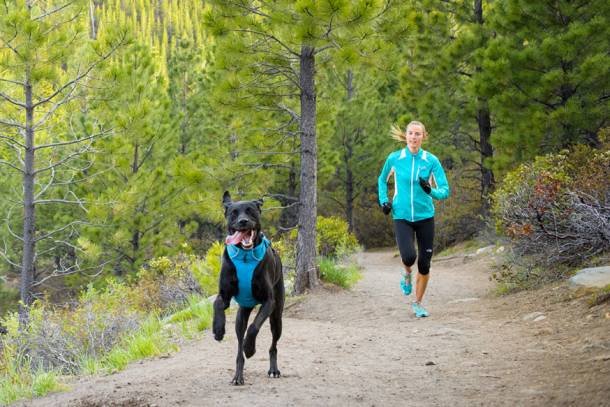Just because many dogs can run fast it doesn’t necessarily mean they enjoy running long distances at a set pace, following some form of personal training regime or extreme sport you have devised for them and perhaps conceitedly believe they may enjoy. Dogs are well-known for putting up with anything in order to please their human carers. There is a fine line between running with your dog for enjoyment and running them into the ground. Given the choice most dogs might prefer a walk and a bit of boisterous play.
There are plenty of blogs expounding the virtues of enjoying jogging or running with your dog. They give helpful tips on special equipment that makes the task easier, the health hazards your dog might suffer, training methods and the best breed to choose. Is it reasonable though to actually choose a breed of dog on the basis of whether it is a suitable running partner. And if health hazards are involved, should we be putting a dog at risk just because we haven’t the time or patience to take it for a walk or you sadly cannot find a human buddy.
Keeping up – those are the rules
“I release the hound and let him roam off leash. I continue on my run and let Rodney sprint off, sniff, and do his thing. But he has to catch up to me by the time we get back to the path. Those are our rules. He revels in the burst of freedom, but he yields and returns to me at the end again. He comes close so I can clip him back onto the leash without stopping”.
gearjunkie.com-Running with your dog
As always some owners, as in all things take it too far, literally too far, often 20 miles or more and invent and participate in trendy and extreme and totally unnecessary canine buddy sports such as marathons, canicross, canibike and caniscoot. Others do not heed any advice and just take their poor dog off without any preparation regardless of breed or health considerations.
Some go as far as giving the dog special training to ensure they keep pace, maintain a steady rhythm, drink from a bottle on the move, do not stop to sniff, defecate or pee and keep to the middle of wide paths away from foliage that may distract them. Apparently it is an inconvenience to clear up after the dog or carry a poo bag.
“Running with a bag of dog poop is a bad time. I plan my running route so that Rodney can go near where there is a public garbage can. If you want to maximise your run, this is a crucial thing. Build this “strategy” into your running routes so you’re not stuck carrying a stinky bag for more than a few hundred feet.
gearjunkie.com

Veterinary profession advice
Veterinary professions around the world seem to sit on the fence in regard to any welfare issues involved in running dogs, neither condemning or promoting it. Many veterinarians consider 8 months to 18 months as the best time to start a dog running and of course an expensive full health examination to make sure it is capable. Dogs with arthritis, heart and respiratory disease and breeds with snub noses are thankfully ruled out but owners are warned about injuries, damage to paws on hot tarmac or by salt in cold weather. No consideration is given to possible mental health implications in regard to restricting them from enjoying their natural behaviours.
The pet trade as always doesn’t miss a trick and is obviously keen to encourage the trend as much as possible by providing dog running bootees, special running leads for one or more dogs, drinking canteens, sweat bands and who knows what. None of which would be necessary if we didn’t insist on having a canine running buddy instead of a human one.
One of the most infuriating things for some dog lovers and me is to see a person jogging with their dog, headphones on or looking down at their Fitbit or phone without checking on their dog at all. They are often oblivious that their dog may be in discomfort or needing a water break. Dogs will naturally slow down or stop just like us humans when they get tired, but for some runners this is not allowed. Many will soldier on because they want to please and are eager to remain at our sides or preferably in front which only makes them strive even more.
I am all for spending as much time as possible with your dog, but for me the increasing trend to utilise dogs in extreme sports and as part of personal training is a step to far. It is an unnecessary, unnatural and arguably harmful pastime which perhaps should be discouraged.


